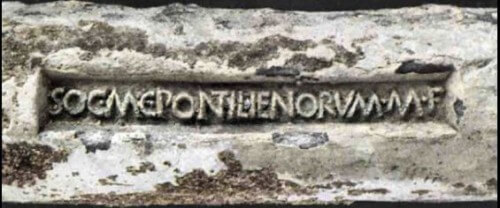The lead treasures hidden in ancient shipwrecks separate hawkish scientific camps

A dispute has broken out between archaeologists and physicists who covet, each side for its own reasons, lead from the Roman period. The ancient lead is purer, denser and much less radioactive than the metal mined today, and therefore provides perfect protection for sensitive experiments in physics. But lead also has historical importance, and many archaeologists object to the smelting of 2,000-year-old ingots.
"Are these experiments so important that it is worth destroying pieces of our past to discover something about our future?" asks Elena Perez-Alvaro, a research student in archeology from the University of Birmingham in England, who wrote an article about the dilemmas involved in the subject in the Rosetta journal.
In their time, the Romans used lead to make coins, pipes, building materials and weapons. Private companies currently collect the lead from the sites of ancient shipwrecks and sell it to their customers, many of whom are physicists. "If this kind of use increases, we may lose all Roman lead, and with it all the information it can provide us about ancient technology, shipping, trade and all," says archaeologist John Kerman of the University of Birmingham.
Physicists argue that the use of this metal is justified in important applications, such as in the search for dark matter, the substance theorized to make up more than a quarter of the mass of the universe. "None of us do this lightly, we don't want hysterical objects to be needlessly destroyed," says Stanford University physicist Blas Cabrera. Cabrera is the spokesman for the "supercryogenic search for dark matter" project in Minnesota, where lead is used to protect the detector.
And in physics, ancient lead can help unravel mysteries that far predate the Romans. "These experiments may reveal some of the most fundamental properties of the universe and answer questions such as: 'What are we and where did we come from,'" says physicist Fernando Gonzalez-Zalba from the University of Cambridge. "I think there is enormous value in the matter."

7 תגובות
Dan - Thanks for the explanation, it wasn't clear from the article.
Lead in nature contains residues of radio-active heavy metals that turn the lead into a radioactive state. The radioactivity isotopes have half-lives of tens of different. That is, after the separation from the dead
The heavy blows have to wait a long time until the decay to stable isotopes.
In this case I am with the historians, destroying historical documents in order to build a detector, sounds to me like the melting of metals during the Borgia period in order to fight Italy's enemies. In 10 years this problem is solved at least 5 times, without destroying any historical documents.
After realizing that the Romans didn't have an iPhone, it doesn't matter what they did have
The following is a "start-up" lead improvement factory using an ancient method. The Romans used to use lead for utensils, and even as an additive to food and wine (in the form of a white powder). Because the poultry is sweet. Some claim that this is what caused Nero's madness. and other symptoms of lead poisoning.
Why is the ancient lead purer, denser and much less radioactive than the metal mined today?
2000 year old lead will reveal fundamental properties of the universe - well... really... just greed of physicists.